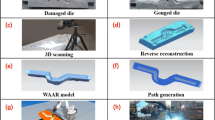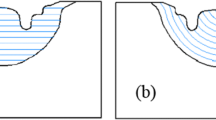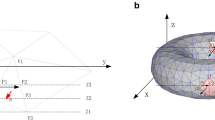Abstract
Wire and arc additive remanufacturing (WAAR) technology is a promising alternative to manual arc surfacing for repairing large metal components. In this paper, the WAAR process of hot-forging dies is preliminarily studied by taking the automobile front axle die as an example. Firstly, a WAAR system is designed by integrating various hardware equipment. Simultaneously, a path generation software is developed based on Python. Then, several core techniques of WAAR are researched. Based on reverse reconstruction technology and Boolean operations, the WAAR model is built quickly and accurately. A layer height adaptive adjustment method is proposed to improve the remanufacturing accuracy, which determines the layer height by comparing the volume of the model and the actual molten metal. The pose of the welding torch is adjusted, and the solution method of Euler angles representing the pose of the welding torch is described. To achieve the goal of improving die performance, different materials are designed according to specific needs and distributed in a gradient. At last, the repair experiment of the front axle die verifies that the WAAR system and process are efficient and reliable.
















Similar content being viewed by others
References
Kashani H, Amadeh A, Ghasemi HM (2007) Room and high temperature wear behaviors of nickel and cobalt base weld overlay coatings on hot-forging dies. Wear 262(7–8):800–806
Morrow WR, Qi H, Kim I, Mazumder J, Skerlos SJ (2007) Environmental aspects of laser-based and conventional tool and die manufacturing. J Clean Prod 15(10):932–943
Chen CR, Wang Y, Ou HG, He Y, Tang XZ (2014) A review on remanufacture of dies and moulds. J Clean Prod 64:13–23
Jhavar S, Paul CP, Jain NK (2013) Causes of failure and repairing options for dies and molds: a review. Eng Fail Anal 34:519–535
Barrau O, Boher C, Gras R, Rezai-Aria E (2003) Analysis of the friction and wear behaviour of hot work tool steel for forging. Wear 255:1444–1454
Podgrajsek M, Glodez S, Ren Z (2015) Failure analysis of forging die insert protected with diffusion layer and PVD coating. Surf Coat Technol 276:521–528
Zhang JS, Zhou J, Tao YP, Shen L, Li MY (2015) The microstructure and properties change of dies manufactured by bimetal-gradient-layer surfacing technology. Int J Adv Manuf Technol 80(9–12):1807–1814
Liu DS, Liu RP, Wei YH, Pan P (2013) Influence of carbon content on shock hardening behavior of cobalt-base hardfacing deposits. Mater Manuf Processes 28(6):643–649
Shen YH, Wei YH, Liu RP (2021) A path generation method for wire and arc additive remanufacturing of complex hot-forging dies. Int J Adv Manuf Technol 117(5–6):1935–1943
DebRoy T, Wei HL, Zuback JS et al (2018) Additive manufacturing of metallic components - process, structure and properties. Prog Mater Sci 92:112–224
Zhang Y, Wu LM, Guo XY et al (2018) Additive manufacturing of metallic materials: a review. J Mater Eng Perform 27(1):1–13
Qi H, Azer M, Singh P (2010) Adaptive toolpath deposition method for laser net shape manufacturing and repair of turbine compressor airfoils. Int J Adv Manuf Technol 48(1–4):121–131
Kumar LJ, Nair CGK (2016) Laser metal deposition repair applications for Inconel 718 alloy. Mater Today Proc 4(10):11068–11077
Kattire P, Paul S, Singh R, Yan WY (2015) Experimental characterization of laser cladding of CPM 9V on H13 tool steel for die repair applications. J Manuf Process 20:492–499
Watson JK, Taminger KM, Hafley RA, Petersen DD (2002) Development of a prototype low-voltage electron beam freeform fabrication system. Proceedings of 13th SFF Symposium 458–465
Taminger KM, Hafley RA, Dicus DL (2002) Solid freeform fabrication: an enabling technology for future space missions. In: Proceedings of the 2002 international conference on metal powder deposition for rapid manufacturing, San Antonio. Princeton: Metal Powder Industries Federation 2002:51–61
Mehnen J, Ding JL, Lockett H, Kazanas P (2014) Design study for wire and arc additive manufacture. Int J Prod Dev 19(1):2–20
Ding DH, Pan ZX, Cuiuri D, Li HJ (2015) A practical path planning methodology for wire and arc additive manufacturing of thin-walled structures. Robot Comput-Integr Manuf 34:8–19
Li YZ, Han QL, Horvath I, Zhang G (2019) Repairing surface defects of metal parts by groove machining and wire plus arc based filling. J Mater Process Technol 274
Motta JMST, Llanos CH, Carvalho GC, Alfaro SCA (2010) A prototype of a specialized robotic system for repairing hydraulic turbine blades. In: 2010 1st international conference on applied robotics for the power industry, CARPI, p 5624449
Zhu S, Liang Y (2006) Path planning for MIG surfacing of robot-based remanufacturing system. China Weld 15(4):59–62
Li XL, Han QL, Zhang GJ (2021) Large-size sprocket repairing based on robotic GMAW additive manufacturing. Welding in the World 65(5):793–805
Zhang JS, Wang QY, Xiao GQ, Zhou J (2021) Filling path planning and polygon operations for wire arc additive manufacturing process. Math Probl Eng :6683319
Funding
The project is funded by the Priority Academic Program Development of Jiangsu Higher Education Institutions (PAPD).
Author information
Authors and Affiliations
Corresponding author
Ethics declarations
Conflict of interest
The authors declare no competing interests.
Additional information
Publisher's note
Springer Nature remains neutral with regard to jurisdictional claims in published maps and institutional affiliations.
Recommended for publication by Commission I - Additive Manufacturing, Surfacing, and Thermal Cutting.
Rights and permissions
About this article
Cite this article
Shen, Y., Wei, Y., Li, Z. et al. Wire and arc additive remanufacturing of hot-forging dies: a preliminary study. Weld World 66, 1691–1702 (2022). https://doi.org/10.1007/s40194-022-01329-x
Received:
Accepted:
Published:
Issue Date:
DOI: https://doi.org/10.1007/s40194-022-01329-x




